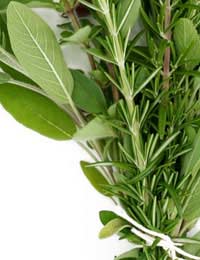
Fresh herbs are wonderful – but they’re a seasonal treat. So, if you love cooking or gardening with herbs, knowing how to store them is essential. Here’s our guide to storing, drying and freezing herbs.
Which Herbs Can Be Dried?
As a rule, ‘woody’ herbs like rosemary, thyme, sage, lovage, bay and tarragon, can be dried. ‘Softer’ herbs like basil, parsley, coriander, chives, and mint, are best frozen.
Drying Herbs
Drying your herbs is extremely easy. Cut your herbs on a dry day, and check them for bugs. Then remove the bottom few leaves and tie four or five stems into a neat bundle. To prevent falling leaves, put the bundle into a paper bag and fasten it loosely around the stems. Suspend your bagged bunches in a warm place. If you don’t have an appropriate place to hang them, skip the paper bag, and spread the bunches on a wire rack. Leave in front of a sunny window until they’re dry.
To store the dried herbs, strip the leaves from the stems and put into airtight containers (spice jars). Label, and keep in a cool, dark cupboard. Make your own herb blends by combining (for example) bay leaf, marjoram, thyme and rosemary, a homemade ‘Herbes de Provence’ mix, which makes a nice Christmas present.
Freezing Herbs
That’s the woody herbs dealt with; now let’s move on to the soft herbs. Coriander, basil, parsley and chives, as well as the soft-woody mint, are better suited to freezing. Just check for bugs, finely chop, and pack into ice-cube trays (keeping different herbs apart). Fill with water and freeze. After a couple of hours, when the cubes are frozen, pack them into freezer bags, label, and freeze until required. Chopped mint and purple rosemary flowers make lovely ice-cubes to float in homemade lemonade!
Making Herb Oil
When your passion for herb gardening takes off, you may have excess herbs that can be used to make flavoured oils. Herb oil is good for dipping bread or to add extra depth to your cooking. To make it, wash and dry your chosen herb (rosemary, thyme, oregano and marjoram work well), then put it into a saucepan and cover with olive oil. Bring to a simmer, then switch off the heat and cover the pan. Leave the oil to infuse with herby flavour – an hour or longer – then strain carefully, through muslin, into a clean, sterilised bottle. Keep it in a cool, dark place.
Drying Lavender
Cut lavender for drying as soon as it flowers. Cut stems as close to the plant as you can, and spread them out on a tray in the airing cupboard (sunshine will fade the lavender colour). When it’s crumbly to touch, rub the lavender heads to release the florets, and store them in an airtight jar. You can use them to fill homemade lavender hearts, or blitz with sugar to give your baking a lavender flavour. Don’t discard the stems – tie them with pretty ribbon and throw them on the fire in winter to scent your home.
